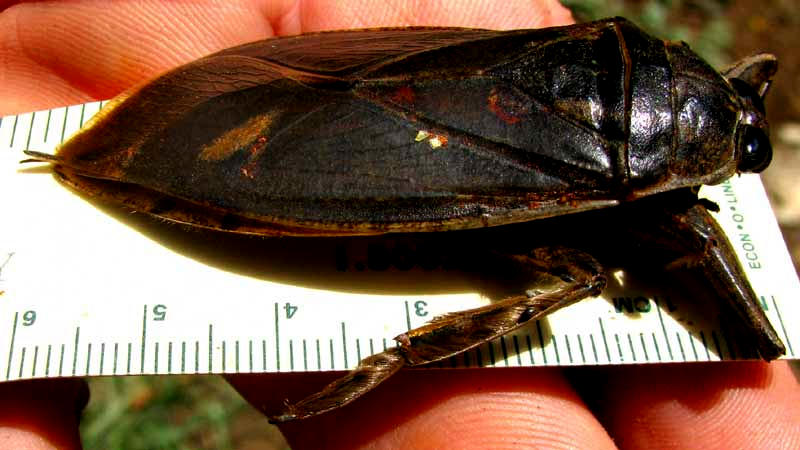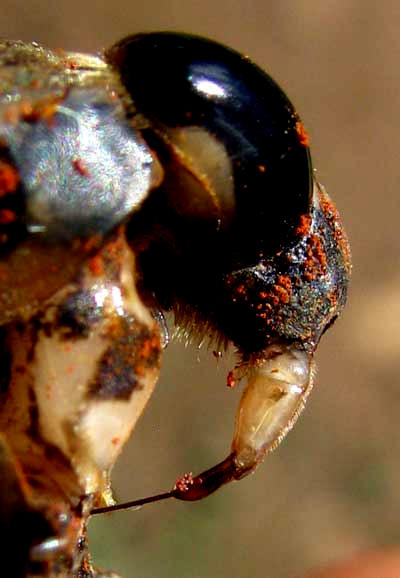Excerpts from Jim Conrad's
Naturalist Newsletter

from the April 3, 2011 Newsletter issued from Hacienda Chichen Resort beside Chichén Itzá Ruins, central Yucatán, MÉXICO; limestone bedrock, elevation ~39m (~128ft), ~N20.676°, ~W88.569°
A BIG TOE-BITER
One problem with writing and philosophizing is that at the end of the day you never know whether you've made advancements, or if in fact you've just confused yourself more than before. Therefore lately I've been enjoying the opportunity to dig a big hole at the Hacienda, for a future septic tank, one maybe ten by ten feet across (3 x 3m) and about the same depth. After sweating at that job for awhile, at least you can see the dirt you've thrown out, and see that you're deeper down than before.
So, that's what I was doing when my shovel dislodged a big red clod of dirt beneath which was the item shown at the top of this page.
You can see that the critter was about 6cms long, or about 2-1/3rd inches. The bug seemed to be in a state of suspended animation. With a little prodding he'd move his legs, but later he seemed inert. I placed him on a chair in the hut and overnight he disappeared, either having escaped, or being eaten by a rat.
At first glance you think that what's in the picture is a big cockroach, but then you remember that cockroaches have shield-like plates, or pronotums, covering their thorax and the backs of their heads, nearly hiding their heads, but this insect's head with bulging compound eyes is very apparent. Also, cockroach legs aren't flattened like this one's. A better look at its paddlelike legs is shown from below, below:

And cockroaches have chewing mouthparts, not long, slender beaks such as this critter's, shown below:

I'd seen something like this back in Mississippi, calling it a Giant Waterbug, but I couldn't remember if it was the same thing, so off the pictures went to good ol' Bea in Ontario. It wasn't long before she shot back that it was indeed a giant waterbug of the True Bug Order, the Hemiptera, and the Giant Waterbug Family, the Belostomatidae, but several similar waterbug species exist in that family and she couldn't be absolutely sure which it was.
Bea's best bet is that it's LETHOCERUS GRISEUS*, known up North as the Eastern Giant Waterbug, or, more affectionately, as the Giant Toe-Biter, since they are suspected of inflicting painful bites to toes on feet dangled over the edges of docks. To be absolutely positive about which species it is we'd need to see such things as whether there's a pad of "fur" rather than a groove on the inner face of the fore femur.
Bea further writes that giant waterbugs prey on any animal small enough to grab with their front legs: aquatic arthropods, snails, small fish, tadpoles, frogs, and even small birds. Once they've caught their prey they inject enzymes through their beaks that kill the prey and start the digestion process. Once the prey's insides are broken down, the toe-biter sucks the liquid out through their beaks.
So, what was a very lethargic toe-biter doing beneath a clod in my five-ft-deep hole toward the end of a tropical dry season? Toe-biters fly around at night and are attracted to lights, so maybe this one was drawn to the Hacienda's security lamps, then at dawn sought shelter in my hole. But why so lifeless?
¿Quién sabe? as they say here -- Who knows?